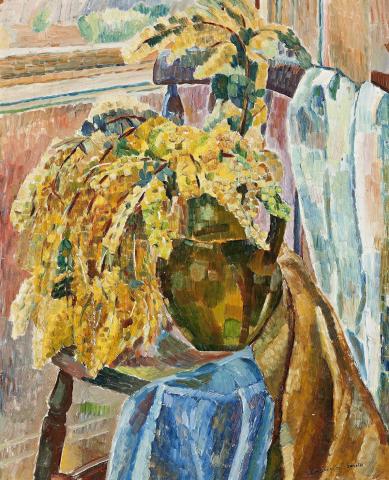GOLDEN WATTLE INTERIOR, c.1955
GRACE COSSINGTON SMITH
oil on board
49.5 x 40.0 cm
signed lower right: G. Cossington Smith.
Macquarie Galleries, Sydney (label attached verso)
Treania Smith, Sydney
Dr J. P. Rasmussen OAM, Sydney
Macquarie Galleries, Sydney, 1975
A Private Eye in a Public Place, St. Swithun's, Pymble, October 1980, cat. 63
Abbotsleigh Centenary Arts Festival, Sydney, November 1985, cat. 68
A Private Collection: A Century of Australian Heritage, S.H. Ervin Gallery, Sydney, 20 June – 21 July 1991, cat.17
The finding of beauty in everyday things, combined with a unique sense of colour and light distinguishes the work of Grace Cossington Smith above all other Australian artists. A room, the garden, a bowl of native flowers become something wondrous, golden and glowing. And here lies that fascinating paradox of the simplicity of the subject and the profundity of its meaning. Golden wattle is the national floral emblem, displaying the Australian colours of green and gold. Resistant to droughts and fires, and harbinger of spring, it characterizes the Australian spirit. In Golden Wattle Interior, c.1955, Cossington Smith embraces this and raises it to another level through her use of light suffused with colour. Through her brush, the light of this world becomes a metaphor of enlightenment. ‘My chief interest, [she said], ... has always been colour, but not flat crude colour, it must be colour within colour, it has to shine; light must be in it...’1 Smith’s still life paintings thereby extend beyond being an expression of the enjoyment of the visual world to an exploration of the spiritual found therein.
Golden Wattle Interior is a classic example. It sparkles with light and colour, especially yellow, ‘the colour of the sun’, as she described it.2 Added pictorial significance is given to this life force by contrasting the cool blues on one side with the warmth of pinks on the other. Enlivened by individual strokes of pure colour, juxtaposed and contrasted, all is in a state of heightened movement swirling around the centrally positioned jug of wattle. Delighting once again in paradox – still life and movement – even the immobility of the jug finally gives way to its glazed surface of dancing strokes of colour. Mosaic-like in paint; it differs in that its light comes from within, not reflected.
While the figurative elements of Cossington Smith’s pictures are readily discernable, the overall effect transcends reality. The prosaic becomes poetic in the embracing harmony of a hymn of visual praise. The vibrancy of paintwork is stilled only by the serenity of inner tranquility. The seeming simplicity of concept and response, one of those marvelous paradoxes of creativity, is wedded to an intimacy that invites participation and admiration. Writing many years ago, Ethel Anderson said of her work, ‘Miss Grace Cossington Smith’s pictures have the cool elegance of hail, or of cherry blossoms after a spring shower. They are high-pitched and clear ... And they are all happy pictures. Miss Cossington Smith seems to paint for no other reason than to express her pleasure in life.’3 Though outwardly paintings of furniture and flowers, inwardly they are essays of enjoyment for sharing with the viewer.
1. The artist in conversation with de Berg, H., 16 August 1965, National Library of Australia, Canberra, quoted in Modjeska, D., Stravinsky’s Lunch, Picador, Pan Macmillan Australia, Sydney, 1999, p. 227
2. Modjeska, ibid, p. 225
3. Anderson, E., ‘Happy pictures by a young Australian artist’, Walkers Monthly, London, April 1932, quoted in Thomas, D., Grace Cossington Smith, Art Gallery of New South Wales, Sydney, 1973, p. 7
DAVID THOMAS
